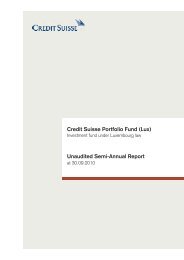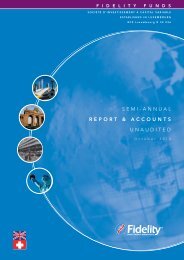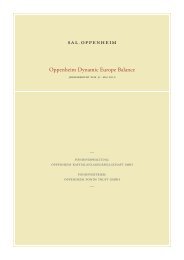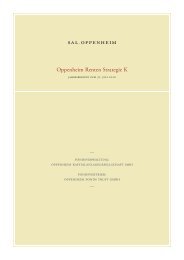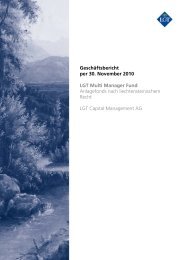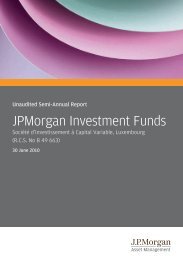Verkaufsprospekt
Verkaufsprospekt
Verkaufsprospekt
Erfolgreiche ePaper selbst erstellen
Machen Sie aus Ihren PDF Publikationen ein blätterbares Flipbook mit unserer einzigartigen Google optimierten e-Paper Software.
4. Additional Risk Factors<br />
The general risk factors set out in the "Risk Factors" section<br />
of the Prospectus apply to the Sub-Fund. In addition,<br />
the following risk factors apply to the Sub-Fund. These risk<br />
factors may not be a complete list of all risk factors associated<br />
with an investment in the Sub-Fund:<br />
Credit Risk: There can be no assurance that the issuers<br />
of securities or other instruments in which a Sub-Fund may<br />
invest will not be subject to credit difficulties, leading to<br />
either the downgrading of such securities or instruments,<br />
or to the loss of some or all of the sums invested in such<br />
securities or instruments or payments due on such securities<br />
or instruments. Sub-Funds may also be exposed to a<br />
credit risk in relation to the counterparties with whom they<br />
transact or place margin or collateral in respect of transactions<br />
in FDI and may bear the risk of counterparty default.<br />
When a Sub-Fund invests in an security or other instrument<br />
which is guaranteed by a bank or other type of financial<br />
institution there can be no assurance that such guarantor<br />
will not itself be subject to credit difficulties, which<br />
may lead to the downgrading of such securities or instruments,<br />
or to the loss of some or all of the sums invested in<br />
such securities or instruments, or payments due on such<br />
securities or instruments.<br />
Emerging Markets Risk: Investment in the securities of<br />
companies in 'emerging' or 'developing' countries, or investment<br />
in certain securities markets in 'emerging' or<br />
'developing' markets may involve a high degree of risk and<br />
may be considered speculative. Risks include (i) greater<br />
risk of expropriation, confiscatory taxation, nationalization,<br />
and social, political and economic instability; (ii) the small<br />
current size of the markets for securities of 'emerging' or<br />
'developing' market issuers and the currently low or nonexistent<br />
volume of trading, resulting in lack of liquidity and<br />
in price volatility; (iii) certain national policies which may<br />
restrict the Sub-Fund's investment opportunities including<br />
restrictions on investing in issuers or industries deemed<br />
sensitive to relevant national interests; (iv) the absence of<br />
developed legal structures governing private or foreign<br />
investment and private property; (v) the legal infrastructure<br />
and accounting, auditing and reporting standards in<br />
'emerging' or 'developing' markets may not provide the<br />
same degree of shareholder protection or information to<br />
investors as would generally apply internationally; (vi)<br />
potentially a greater risk regarding the ownership and<br />
custody of securities i.e. in certain countries, ownership is<br />
evidenced by entries in the books of a company or its<br />
registrar. In such instances, no certificates representing<br />
ownership of companies will be held by the Trustee or any<br />
of its local correspondents or in an effective central depository<br />
system; and (vii) 'emerging' or 'developing' markets<br />
may experience significant adverse economic developments,<br />
including substantial depreciation in currency exchange<br />
rates or unstable currency fluctuations, increased<br />
interest rates, or reduced economic growth rates than<br />
investments in securities of issuers based in developed<br />
countries.<br />
The economies of 'emerging' or 'developing’ markets, in<br />
which the Sub-Fund may invest, may differ favourably or<br />
PineBridge Asia Balanced Fund<br />
unfavourably from the economies of industrialised countries.<br />
The economies of 'emerging' or 'developing' countries<br />
are generally heavily dependent on international trade<br />
and have been and may continue to be adversely affected<br />
by trade barriers, exchange controls, managed adjustments<br />
in relative currency values and other protectionist<br />
measures imposed or negotiated by the countries with<br />
which they trade. Investments in 'emerging' or 'developing'<br />
markets entail risks which include the possibility of political<br />
or social instability, adverse changes in investment or<br />
exchange control regulations, expropriation and withholding<br />
of dividends at source. In addition, such securities may<br />
trade with less frequency and volume than securities of<br />
companies and governments of developed, stable nations<br />
and there is also a possibility that redemption of Units<br />
following a redemption request may be delayed due to the<br />
illiquid nature of such investments.<br />
Financial Derivative Instruments: The prices of FDI,<br />
including futures and options, are highly volatile. Price<br />
movements of forward contracts, futures contracts and<br />
other derivative contracts are influenced by, among other<br />
things, interest rates, changing supply and demand relationships,<br />
trade, fiscal, monetary and exchange control<br />
programs and policies of governments, and national and<br />
international political and economic events and policies. In<br />
addition, governments from time to time intervene, directly<br />
and by regulation, in certain markets, particularly markets<br />
in currencies and interest rate related futures and options.<br />
Such intervention is often intended directly to influence<br />
prices and may, together with other factors, cause all of<br />
such markets to move rapidly in the same direction because<br />
of, among other things, interest rate fluctuations.<br />
The use of FDI also involves certain special risks, including:<br />
(1) dependence on the ability to predict movements in<br />
the prices of securities being hedged and movements in<br />
interest rates, (2) imperfect correlation between the price<br />
movements of the derivatives and price movements of<br />
related investments, (3) the fact that skills needed to use<br />
these instruments are different from those needed to select<br />
the Sub-Fund’s securities, (4) the possible absence of a<br />
liquid market for any particular instrument at any particular<br />
time, (5) possible impediments to effective portfolio management<br />
or the ability to meet redemptions, (6) possible<br />
legal risks arising in relation to derivative contract documentation,<br />
particularly issues arising relating to enforceability<br />
of contracts and limitations thereto, (7) settlement<br />
risk as when dealing with futures, forwards, swaps, contracts<br />
for differences the Sub-Fund’s liability may be potentially<br />
unlimited until the position is closed, and (8) counterparty<br />
risk as the use of OTC derivatives, such as futures,<br />
forward contracts, swap agreements and contracts for<br />
differences will expose the Sub-Fund to credit risk with<br />
respect to the counterparty involved.<br />
The Sub-Fund may invest in certain derivative instruments,<br />
which may involve the assumption of obligations as well as<br />
rights and assets. Assets deposited as margin with brokers<br />
may not be held in segregated accounts by the brokers<br />
and may therefore become available to the creditors of<br />
such brokers in the event of their insolvency or bankruptcy.<br />
The Sub-Fund may from time to time utilise both exchange-traded<br />
and OTC credit derivatives as part of its<br />
| 61



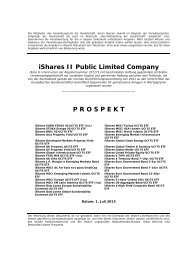
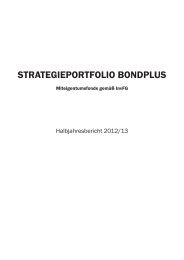

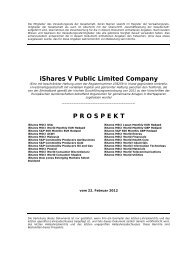
![Prospectus Simplifié daté de [Mars] 2005](https://img.yumpu.com/18875582/1/190x245/prospectus-simplifie-date-de-mars-2005.jpg?quality=85)

